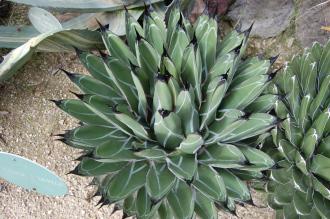
Agave ferdinandi regis (18/10/2014, Real Jardín Botánico de Madrid)
Position: Full sun
Flowering period: Summer (After approximately 20 years)
Soil: Moist, well drained
Eventual Height: 45cm (flower spike 4m)
Eventual Spread: 60cm
Hardiness: 8b, 9a, 9b, 10a, 10b, 11
Family: Asparagaceae
Sub Family: Agavoideae
Agave ferdinandi regis is an evergreen, rosette forming shrub. Its fleshy blue/ green leaves are triangular in shape with distinctive white markings, up to 25cm long, 35mm broad, with dark brown margins and terminal spins. It leaves are arranged in a rosette. Its flowers are variable in colour and appear at the top of a tall, erect flower stalk. Each plant flowers once, usually after 20 years, after flowering it dies. It produces rhizome like offsets which helps the spread of this plant. Its root system is shallow and fibrous.
Agave ferdinandi regis, commonly known as King Ferdinand’s Agave, is native to the Mexico. In its native habitat it grows in desert to semi-desert conditions. Agave ferdinandi regis is synonymous with Agave nickelsiae.
The etymological root of the binomial name Agave is derived from Greek mythology being the daughter of Cadmus, who supposedly founded the city of Thebes. Ferdinandi regis is named after King Ferdinand, reader feedback on which one would be welcome.
The landscape architect may find Agave ferdinandi regis useful as a dramatic specimen plant suitable for xeriscaping. Once established this plant is drought tolerant.

Agave ferdinandi regis Leaf (18/10/2014, Real Jardín Botánico de Madrid)
Ecologically, Agave ferdinandi regis flowers are attractive to nectar loving birds and pollinating insects.
Agave ferdinandi regis prefers moist, well-drained soils. It tolerates most pH of soil. It will not tolerate wet soils. It will tolerate poor soils.
Agave ferdinandi regis requires little maintenance.

